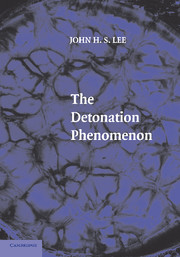Book contents
- Frontmatter
- Contents
- Preface
- 1 INTRODUCTION
- 2 GASDYNAMIC THEORY OF DETONATIONS AND DEFLAGRATIONS
- 3 DYNAMICS OF DETONATION PRODUCTS
- 4 LAMINAR STRUCTURE OF DETONATIONS
- 5 UNSTABLE DETONATIONS: NUMERICAL DESCRIPTION
- 6 UNSTABLE DETONATIONS: EXPERIMENTAL OBSERVATIONS
- 7 INFLUENCE OF BOUNDARY CONDITIONS
- 8 DEFLAGRATION-TO-DETONATION TRANSITION
- 9 DIRECT INITIATION OF DETONATIONS
- Epilogue
- Index
4 - LAMINAR STRUCTURE OF DETONATIONS
Published online by Cambridge University Press: 06 July 2010
- Frontmatter
- Contents
- Preface
- 1 INTRODUCTION
- 2 GASDYNAMIC THEORY OF DETONATIONS AND DEFLAGRATIONS
- 3 DYNAMICS OF DETONATION PRODUCTS
- 4 LAMINAR STRUCTURE OF DETONATIONS
- 5 UNSTABLE DETONATIONS: NUMERICAL DESCRIPTION
- 6 UNSTABLE DETONATIONS: EXPERIMENTAL OBSERVATIONS
- 7 INFLUENCE OF BOUNDARY CONDITIONS
- 8 DEFLAGRATION-TO-DETONATION TRANSITION
- 9 DIRECT INITIATION OF DETONATIONS
- Epilogue
- Index
Summary
INTRODUCTION
In the gasdynamic analysis of detonation waves discussed in Chapter 2, the conservation equations are based on the upstream and downstream equilibrium states only. The detailed transition through the structure of the detonation was not considered. For a given initial upstream state, the locus of possible downstream states is given by the Hugoniot curve. Although the transition from the initial to the final state follows the Rayleigh line, the intermediate states along the Rayleigh line need not be considered if only the relationships between upstream and downstream are desired. It suffices to have the final state correspond to the intersection of the Rayleigh line with the Hugoniot curve.
Because the gasdynamic theory of detonation is concerned with the relationships between the upstream and downstream equilibrium states only, shocks, detonations, and deflagrations can all be analyzed using the conservation equations across the front. The conservation equations do not require the mechanism for the transition across the wave to be specified. However, to describe this transition zone, a model for the structure of the detonation wave must be defined. The model specifies the physical and chemical processes that are responsible for transforming the initial state to the final state. Most of the early pioneers of detonation research proposed the mechanism responsible for the propagation of the detonation implicitly in their discussion of the phenomenon.
- Type
- Chapter
- Information
- The Detonation Phenomenon , pp. 73 - 97Publisher: Cambridge University PressPrint publication year: 2008



